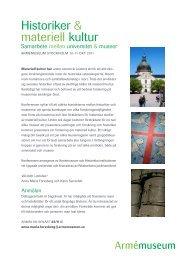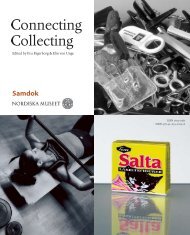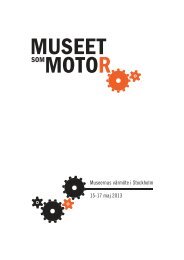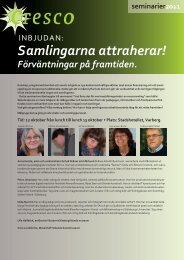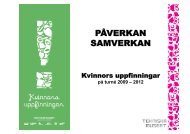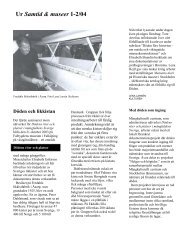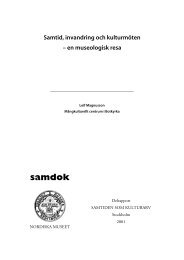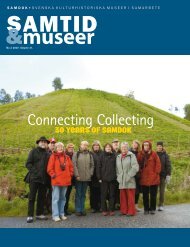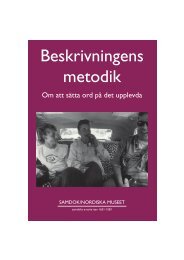Etnografiska utmaningar på nätet - Nätverket - Uppsala universitet
Etnografiska utmaningar på nätet - Nätverket - Uppsala universitet
Etnografiska utmaningar på nätet - Nätverket - Uppsala universitet
Create successful ePaper yourself
Turn your PDF publications into a flip-book with our unique Google optimized e-Paper software.
Surfing Conversations. The development of a methodological approach to the Internet as practice#existing shopping practices using a practice-orientedapproach, and it was this idea that helped to developthe method of the ethnologic Design Game.The second question was whether virtual groceryshopping will generate new practices. We determinedthat the Internet should not simply be consideredtechnology, but should be seen as a separate yetconnected entity that was entangled into the practiceof grocery shopping. From this, CKA developed theSurfing Conversation as a method that could be used toinvestigate Internet practice because it also consideredsignificant off-line entities — for example, what a userpreferred to cook for dinner. As methods, the ethnologicDesign Game investigated practices of conventionalgrocery shopping, and the Surfing Conversationincorporated this knowledge into the overall processof the interactive grocery shopping of the future.From user-driven innovationto practice-orientedinnovationIn the following section, we will discuss how CKAaddressed these questions. The departure point wasuser-driven innovation, but this was developed into thespecific approach of practice-oriented innovation. In thefield of contemporary cultural analysis, the term userdriveninnovation has been used to identify a wide rangeof approaches that are believed to be somehow morefaithful to what the users ”really” want from technologyand product innovation. CKA does not contend tohold a position on user-driven innovation. However,CKA does claim to have the ability to gain importantknowledge from users through the use of ethnographicmethods. In the grocery-shopping project, this wasaccomplished by developing empirically specific anduser-reflexive methods. As a project assigned to CKA,the investigation also needed to deliver a certain kindof results. Because of this, CKA could not engage in anideal type of user-driven innovation, where the usersconduct the entire innovative process. Additionally,we do not think that ”democratizing innovation” (vonHippel 2005) through a user-driven approach is anobvious benefit to the process — this demands thatevery single product should be specifically designed foreach user, or that the final product is a ”democratized”product, which actually does not fit anyone. Instead,CKA has developed methods that involve the user in areflexive process — meaning that the users participate inthe fieldwork by deciding what to talk about and where,while remaining in the setting of grocery shopping.This is a practice-oriented approach. Instead of focusingon the users, the product or the relationship betweenthem, CKA analyzes the practices that the productshould be designed to engage in, as well as the processof transforming these practices (Shove et al. 2007).3von Hippel uses the term ‘user-centred innovation.’In ”The Design of Everyday Life,” the authors (Shoveet al. 2007) present practice-as-entity and practiceas-performanceas key concepts of practice-orienteddesign (Shove et. al 2007:148). The practice-as-entityis the specific action of doing something — it is “atemporally unfolding and spatially dispersed nexus ofdoings and sayings” (Shove et al. 2007:13). The practiceas-performanceis the “active process of doing throughwhich the practice-as-entity is sustained, reproduced andpotentially changed” (Shove et al. 2007:13). Hence, theentity and performance is co-constitutive and shouldnot be viewed as two separate and distinct sorts ofpractice. The practice-oriented approach “centres noton objects, and not on users and consumers, but on themore encompassing dynamics of practice” (Shove et al.2007:134). As such, the focus is on doings: The practiceor performance as an assemblage of a wide range ofelements that cause a user to do something, and therebyconstitute the specific entity. Changing elements inthe performance can cause changes in the entity. Auser-driven innovative approach may be fruitful inproducing products for a certain practice. However,the performance will be changed when bringing a newproduct to the users. Conversely, a practice-orientedapproach investigates the practices in which a productis supposed to engage users, and hence transform thepractices.In the case of grocery shopping, a lot of people aredoing almost the same thing: going to a store to buygroceries. This is the entity, but the performancecan take many different configurations. Fieldworkconducted with Beth and Amanda exemplifies thedifference in performance. Beth is retired from workand goes to the grocery store to meet other people,and not only to buy groceries: “There can be days where Idon’t see other people than those over there [in the grocerystore]. I think it’s nice to come over here, and get a chat.”Compared to Amanda, who is a working mother andwhose daughter’s swimming lessons on Fridays are animportant part in the performance of which groceries tobuy, when they should be consumed, etc.: “On Fridays,our daughter has swimming lessons, so we have to eatquite early. Friday is a day when everything just has tobe easy.” Both Beth and Amanda do grocery shopping,but for quite different reasons. Their practices are anassemblage of very different elements into a similarentity, but with different performances.The approach of practice-oriented product designengages these concepts by investigating the practicesthat a product is supposed to fit into — both as entityand performance. It is not only which use the productenables or which opportunities it offers. A new productwill change practice, or even cause new kinds of practice.In the case of Beth, grocery shopping solely on theInternet would prevent the practice she wanted from4Shove et al. cites this quotation from professor of philosophy,Theodore R. Schatzki.9Nätverket 2010: 17: 8–16http://natverket.etnologi.uu.se



